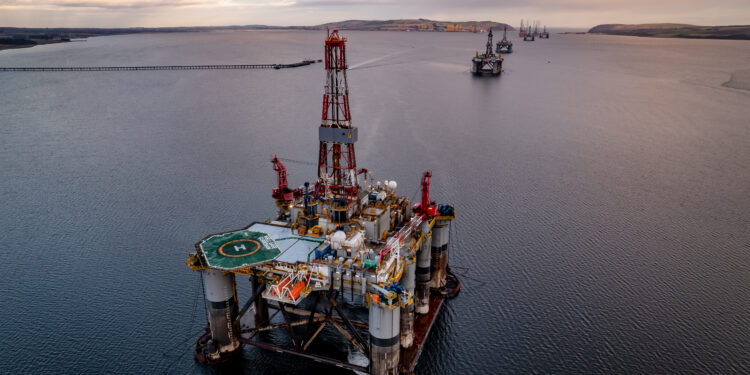Archrock, Inc. (NYSE:AROC) is a leading provider of natural gas compression services in the United States, playing a critical role in the nation’s energy infrastructure by ensuring that natural gas flows efficiently from production sites to processing facilities, pipelines, and end users. Headquartered in Houston, Texas, the company has built a dominant position in the contract compression and aftermarket services segment through decades of operational expertise, technical innovation, and an expansive network that spans nearly every major oil and gas basin in the country. Archrock’s services are essential to maintaining pressure and reliability within the natural gas value chain, enabling producers and midstream operators to optimize their operations and ensure the steady delivery of cleaner-burning energy across the U.S. and beyond.
With a history tracing back more than 65 years, Archrock has evolved alongside America’s energy transformation—from early gas field development to today’s complex, data-driven compression networks. The company owns and operates one of the largest standardization-based fleets in the industry, measured in horsepower, and provides full-service contract compression solutions that include equipment installation, operations, maintenance, and optimization. Archrock’s aftermarket services division further supports customers by offering parts, repair, and field services for natural gas compression equipment, making the company a one-stop partner for both owned and contracted assets. This integrated business model has allowed Archrock to generate recurring, predictable revenues even during commodity downcycles, giving it a reputation for stability and operational reliability in an otherwise cyclical sector.
Archrock’s success is driven by its commitment to innovation, safety, and environmental stewardship. The company continues to modernize its compression fleet with higher-efficiency units that reduce emissions, improve fuel consumption, and meet the growing demand for environmentally responsible operations. Through advanced monitoring systems and data analytics, Archrock enhances uptime, extends equipment life, and optimizes performance for customers ranging from independent producers to major integrated energy firms. The company’s proactive investment in sustainability aligns with broader industry trends toward cleaner energy and positions Archrock as a strategic enabler of the global transition to lower-carbon fuels.
Financially, Archrock has demonstrated steady growth through disciplined capital allocation, long-term customer contracts, and a focus on maintaining high fleet utilization. Its business model emphasizes recurring cash flows, supported by multi-year service agreements and a large base of contracted horsepower that provides strong visibility into future earnings. Over the years, Archrock has also pursued targeted acquisitions—such as its recent purchases of NGCS and Total Operations Production Services (TOPS)—to expand its geographic footprint and enhance its service capabilities. These moves reflect management’s long-term strategy to consolidate leadership in the compression market while delivering value to shareholders through dividends, debt reduction, and sustainable growth.
At its core, Archrock represents the backbone of America’s natural gas delivery network—a company that combines scale, technology, and operational excellence to meet the evolving needs of the energy sector. As global demand for natural gas continues to rise and the U.S. solidifies its position as a leading LNG exporter, Archrock’s role becomes even more vital. Its decades-long reputation for reliability, its nationwide infrastructure footprint, and its deep expertise in compression technology all reinforce its standing as a cornerstone of the natural gas industry.
Earnings Momentum May Be Peaking as Market Conditions Shift
Archrock’s strong track record of beating earnings expectations is commendable, but investors must consider the context. The recent streak of modest surprises — typically in the 5% to 7% range — coincides with one of the most favorable gas compression environments in recent history. The U.S. experienced near-record gas output through 2024 and early 2025, leading to utilization rates near 96% across Archrock’s fleet. However, natural gas prices have begun to normalize from the highs of early 2025, and production growth is flattening across key basins like the Permian, Haynesville, and Eagle Ford.
As a result, compression demand growth could slow meaningfully heading into 2026. Archrock’s contract model provides partial insulation from price swings, but not immunity. Producers are beginning to re-evaluate service costs amid narrowing margins, and if capital expenditures in upstream development moderate, it could reduce new project starts — and with them, new compression demand.
In essence, Archrock’s impressive EPS beats have been supported by cyclical tailwinds that may now be fading. The company’s ability to sustain double-digit revenue growth and margin expansion beyond the current cycle remains uncertain, particularly as its cost base and leverage profile expand.

CHECK THIS OUT: Gyrodyne (GYRO) Lands $28.74M Deal for 49 Acres in St. James, NAV Jumps 6% and NioCorp (NB)’s $1.14B Elk Creek Project Set to Transform U.S. Critical Minerals Supply.
Rising Costs, Aging Fleet, and Margin Pressure
While Archrock’s revenue has surged to $383.2 million in Q2 2025, gross margins are under mounting pressure due to rising equipment maintenance costs, labor inflation, and higher material expenses. Maintaining a massive horsepower fleet is capital-intensive, and the company’s recent acquisitions — including NGCS and TOPS — have added both assets and operational complexity.
The risk is twofold. First, these acquisitions, though accretive on paper, could fail to deliver anticipated synergies, leading to higher depreciation, integration costs, and reduced cash flow flexibility. Second, with fleet utilization already at historically high levels, Archrock has little room for further efficiency gains. Any dip in utilization — even from 96% to 90% — could significantly dent operating leverage, compressing EBITDA margins and cash flow.
Meanwhile, competition is intensifying as smaller compression providers and even producers themselves adopt newer, more energy-efficient systems, including electric compression solutions. This shift threatens to erode Archrock’s pricing power over time, especially if environmental regulations accelerate the industry’s transition toward lower-emission technologies.
Heavy Leverage Could Exacerbate Downside in a Downturn
One of Archrock’s most concerning risk factors is its high debt load, which stood at approximately $2.6 billion as of mid-2025. The company’s net leverage ratio of around 3.3x EBITDA leaves limited flexibility if interest rates remain elevated or if earnings soften.
Although management has emphasized stable cash flows and long-term contracts as buffers, the underlying business is not immune to macro shocks. A mild slowdown in natural gas infrastructure spending could quickly ripple through Archrock’s customer base, triggering contract renegotiations or reduced renewal pricing. Any such decline in cash generation would force management to make difficult trade-offs between debt reduction, dividend payments, and capital investments.
Debt refinancing risk also looms. Should credit markets tighten or if rating agencies downgrade Archrock’s credit from its current “BB / Stable” level, borrowing costs could increase significantly. Given the capital-intensive nature of the business, this would pressure free cash flow and limit the company’s ability to sustain dividend growth or repurchase shares.
Regulatory and Environmental Risks Cloud Long-Term Outlook
Another structural concern is the growing regulatory scrutiny surrounding the natural gas sector. Archrock’s compression units are critical for moving gas through pipelines, but they also contribute to methane emissions and environmental impact — issues now front and center for policymakers. Potential methane taxes, carbon fees, or equipment efficiency standards could significantly raise compliance costs.
In addition, the global energy transition is gradually steering capital away from traditional fossil fuel infrastructure and toward renewables, carbon capture, and electrification projects. While natural gas remains essential for grid reliability, long-term investor sentiment may continue to shift away from companies like Archrock that are viewed as carbon-intensive service providers. As ESG-linked capital pools expand, Archrock’s cost of capital could rise, and access to low-cost financing could narrow.
Even though management has started exploring more environmentally efficient compression technologies, those transitions require fresh capex — a challenge for a company already managing heavy leverage and modest free cash flow headroom.
Valuation Concerns: High Expectations, Limited Upside
Despite these underlying headwinds, Archrock’s valuation has climbed alongside its earnings momentum. The stock recently traded near $18 before retreating, down 4.48%, as investors began pricing in the risk of a slowdown. The combination of strong historical performance and elevated expectations leaves little room for error.
Archrock’s raised 2025 EBITDA guidance of $810–850 million implies continued expansion, but with market conditions shifting, that optimism could quickly fade if any disruption — regulatory, operational, or macro — occurs. Even a modest compression in valuation multiples could have an outsized effect on share price, especially as investors rotate toward higher-growth sectors.
Moreover, while the Zacks Rank and Earnings ESP indicators suggest that another quarterly beat may be “around the corner,” the market may not reward it in the same way it did previously. Investors are beginning to differentiate between cyclical earnings momentum and sustainable long-term growth. If Archrock delivers another beat but guides cautiously for 2026, shares could underperform despite strong headline numbers.
Investor Psychology and the “Earnings Beat Trap”
There is also a behavioral dimension to consider. Stocks that repeatedly beat earnings estimates can sometimes fall victim to “beat fatigue,” where the market expects consistent outperformance and reacts negatively even to modest guidance or deceleration. Archrock’s recent pattern of small EPS surprises — averaging just over 6% — may not be enough to justify sustained multiple expansion in a capital-heavy, cyclical industry.
Investors should also recognize that the Zacks Expected Surprise Prediction (ESP) metric, while statistically useful, does not account for macro risk, credit exposure, or energy cycle shifts. The market’s focus may soon shift away from near-term beats and toward longer-term sustainability of cash flows — an area where Archrock’s debt and capital intensity pose significant concerns.
The Bearish Outlook: Margin Erosion, Slower Growth, and Re-Rating Risk
Taken together, Archrock’s near-term bullish indicators mask growing vulnerabilities. The company’s strong historical performance has raised expectations to levels that may not be sustainable in a more normalized energy market. With gas production growth flattening, inflation lingering, leverage elevated, and regulatory headwinds intensifying, AROC may face margin compression, slower earnings growth, and potential valuation re-rating over the next several quarters.
Even if the company delivers another earnings beat in October 2025, it could mark the peak of its current cycle rather than the beginning of a new one. Investors chasing short-term momentum risk overlooking the broader structural pressures that could weigh on profitability in 2026 and beyond.
Conclusion: A Solid Operator in a Shaky Environment
Archrock remains a well-managed company with an enviable track record in gas compression, but the risk-reward balance has shifted unfavorably. Its reliance on cyclical upstream activity, heavy capital structure, and exposure to regulatory and inflationary risks make it vulnerable to both market sentiment and macro volatility.
The next few quarters could still deliver short-term strength — potentially even another earnings surprise — but long-term investors should tread carefully. In an industry facing rising costs, technological disruption, and a global energy transition, Archrock’s impressive surface-level stability may conceal more fragility than the market currently acknowledges.
READ ALSO: CEL-SCI (CVM) Stock Could Explode After Saudi Breakthrough Deal and Ondas Holdings (ONDS) Lands $2.7M Defense Order.






